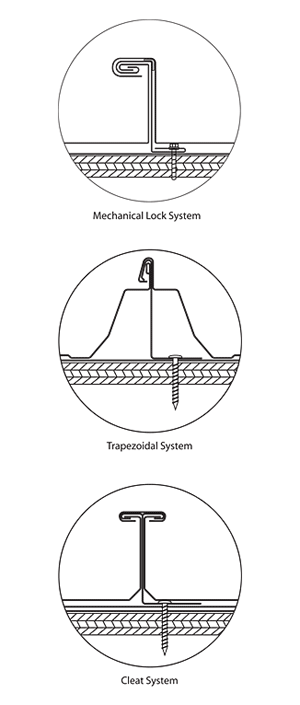Metal Offers Durable, Energy-efficient Roofing Solutions
 Typical Structural Profiles Figure 1 |
|
Structural Panel Profiles. Figure 1 shows some of the most common types of structural panel profiles. The trapezoidal profile is most commonly found in metal building-type applications. The seam at the top may be snapped in place but is usually field-seamed with a mechanical seamer. The cleat profile is a three-piece assembly that is seamed in the field. This panel may be more labor intensive as the cap may be somewhat unwieldy on long panel applications, although it is a profile that can be curved for radius panel applications as well.
Fabrication Methods. Factory-produced structural panels are generally higher in quality than those made in the field because they are manufactured under fixed conditions on state-of-the-art roll forming machinery. On some projects, practical restrictions as to panel length may necessitate production of panels at the jobsite. Architects may also want to weigh the advantages of panel systems that have been designed to be roll-formed on site in terms of transportation cost advantages and any jobsite conditions that could compromise panel quality. Installation cost is another consideration. Panels requiring complicated seaming operations may ultimately prove to be less cost effective. Architects should consider these issues at the panel specification stage.
Code Considerations. All structural panels considered for roofing systems must pass the UL-90 rating requirements of the UL580 test procedure. In this test, all components of the roof system are evaluated for wind resistance, including the roof deck, sub purlins, anchor clips and fasteners, in addition to the panel itself. The panel should be rated over an assembly equal to that designed for the project requirements.
In many cases, specifications require that the roofing panels be tested further by the American Society of Testing and Materials (ASTM), a recognized authority on product evaluation and testing. Some specifications, including those of the Army Corps of Engineers, require that panels be tested under the requirements of the ASTM E1592 test specification, the standard test method for structural performance of sheet metal roof and siding by uniform static air pressure difference. This test applies industry standards for wind uplift capacity, and tests a system to failure to establish design capabilities. It measures a system's bending capacity and attachment strength when subjected to a uniform static pressure, and is used for standing seam, trapezoidal, ribbed or corrugated metal panels from 0.012- to 0.050-inch thickness. An air bag assembly is used to create a vacuum; air pressure is applied beneath the panels. Deflections in the panels are noted at six locations. The test, which creates a static pressure or load that is gradually increased as the test progresses, is taken to the failure point for each panel assembly. The results are used in conjunction with wind design standards to determine required spacing of supports or attachments.
This test procedure is generally not applicable to panels that are installed over solid substrates such as metal decking or plywood. In addition, many specifications require that panels be tested for water infiltration. The ASTM 1646/formerly E331 Standard Test Method for Water Penetration of Exterior Metal Roof Panels by Uniform Static Air Pressure Difference essentially evaluates how resistant the standing-seam panel system is to moderate-to-heavy rains with light winds that are considered "average daily rain events." Specifications may also require that structural panels meet the requirements of ASTM 1680/formerly E 283, which is the standard test method for rate of air leakage through exterior metal roof panels.
Although structural metal roofing panels typically involve higher up-front costs than other roofing alternatives, the low maintenance costs and long life expectancy make it a competitive roofing alternative on most projects. There are a few exceptions, however. Structural metal panels may not be appropriate in roof applications with an extraordinary number of penetrations or in a particularly caustic or aggressive environment, though new coating systems greatly broaden the scope of application.
Aesthetic Factors. While structural roofs are commonly used in schools, industrial facilities, shopping centers, prisons, low-slope commercial buildings and warehouses, their utilitarian applications do not mean they are without aesthetic appeal. A new building to house the headquarters of Bolton & Menk, Inc., a civil and environmental engineering firm located in Mankato, Minnesota, was designed by Paulsen Architects, also of Mankato, to create a unique "engineering" look. "We were dealing with a simple shape overall," says Bryan Paulsen, AIA, "The challenge was how to take a ‘box' and give it a distinctive identity by adding verticality and visual interest." The focal point of the design centered on the main entrance area of the 20,000-square-foot building. Utilizing approximately 1,500 square feet of copper-colored metal flush panels installed horizontally on the walls and complemented with large entry awning "wings" utilizing snap-on panels also with a copper-like finish produced a building that "shimmers during the day and tends to glow at night," according to Paulsen. The entry area roof utilizes 3,700 square feet of silver metallic panels and features a prominent overhang with non-ventilating soffit panels also finished in silver metallic; coordinated silver metallic window frames were used for accent.









